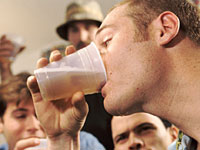By Steven Reinberg, HealthDay
If you're looking to lose those extra pounds, you should probably add
reducing stress and getting the right amount of sleep to the list, say
researchers from Kaiser Permanente's Center for Health Research in
Portland.
In fact, although diet and exercise are the usual prescription for
dropping pounds, high stress and too little sleep (or too much of it)
can hinder weight loss even when people are on a diet, the researchers
report.
"We found that people who got more than six but less than eight hours
of sleep, and who reported the lowest levels of stress, had the most
success in a weight-loss program," said study author Dr. Charles Elder.
Elder speculates if you are sleeping less or more than recommended and
if your stress levels are high, you will not be able to focus on making
behavioral changes.
These factors may also have a biological impact, he added.
"If you want to lose weight, things that will help you include reducing
stress and getting the right amount of sleep," Elder said.
The report, funded by the U.S. National Institutes of Health, is published in the March 29 online edition of the International Journal of Obesity.
In this two-step trial, 472 obese adults were first counseled about
lifestyle changes over a 26-week period. Recommendations included
cutting 500 calories a day, eating a diet rich in fruits, vegetables and
whole grains by following the Dietary Approaches to Stop Hypertension
(DASH) diet approach, and exercising at least three hours a week.
In addition, the researchers asked the participants questions about sleep time, depression, insomnia, screen time and stress.
During this part of the trial, the participants lost an average of
almost 14 pounds. The 60% of the participants who lost at least 10
pounds went on to take part in the next phase of the trial. Those in
the second phase of the trial continued their diet and exercise
program.
Elder's team found the right amount of sleep and stress reduction at
the start of the trial predicted successful weight loss. Lower stress
by itself predicted more weight loss during the first phase of the
trial, they added.
Declines in stress and depression were also important in continuing to
lose weight during both phases of the trial, as were exercise minutes
and keeping food diaries, Elder's group found.
Dr. David L. Katz, director of the Prevention Research Center at Yale University
School of Medicine, said that "while we often tend to look at health
one condition at a time, the reality is that health is best viewed
holistically."
"People who are healthy and vital tend to be healthy and vital not
because of any one factor, but because of many. And the factors that
promote health — eating well, being active, not smoking, sleeping
enough, controlling stress, to name a few —promote all aspects of
health," he added.
This study shows that people are more likely to lose weight when not
impeded by sleep deprivation, stress or depression, he said.
"Anyone who has ever tried to lose weight probably could have said much
the same from personal experience. Similarly, weight loss reduced
stress and depression. This, too, is suggested by sense and common
experience, as it is affirmed by the science reported here," Katz said.
The important message is that weight loss should not be looked at with tunnel vision, Katz said.
"Improving sleep may be as important to lasting weight control efforts
as modifying diet or exercise. Managing stress is about physical
health, as well as mental health. This study encourages weight loss in a
more holistic context," he said.
Another study presented earlier this month at the American Heart Association scientific sessions held in Atlanta found that people of normal weight eat more when they sleep less.
Columbia University
researchers discovered that sleep-deprived adults ate almost 300
calories more a day on average than those who got enough sleep. And the
extra calories mostly came from saturated fat, which can spell trouble
for waistlines.
The researchers came to their conclusions — which should be considered
preliminary until published in a peer-reviewed journal — after
following 13 men and 13 women of normal weight. They monitored the
eating habits of the participants as they spent six days sleeping four
hours a night and then six days sleeping nine hours a night (or the
reverse).
"If sustained, the dietary choices made by people undergoing short
sleep could predispose them to obesity and increased risk of
cardiovascular disease," the researchers wrote in an American Heart
Association news release.
 Recent studies suggest that HGH plays an important role in multiple body functions. By the time you reach 60, your natural production of HGH is most likely to be half of what it was when you were 20. This means that you will may experience less energy, more body fat, and have a weaker immune system. HGH Energizers Health supplement provides nutrients that may be lacking due to the strain that is often put on the body's health. Each serving provides important nutrients to support your overall health and vitality.
Recent studies suggest that HGH plays an important role in multiple body functions. By the time you reach 60, your natural production of HGH is most likely to be half of what it was when you were 20. This means that you will may experience less energy, more body fat, and have a weaker immune system. HGH Energizers Health supplement provides nutrients that may be lacking due to the strain that is often put on the body's health. Each serving provides important nutrients to support your overall health and vitality.


































